Catharanthus roseus
Catharanthus roseus, commonly known as bright eyes, Cape periwinkle, graveyard plant, Madagascar periwinkle, old maid, pink periwinkle, rose periwinkle,[2] is a species of flowering plant in the family Apocynaceae. It is native and endemic to Madagascar, but grown elsewhere as an ornamental and medicinal plant, a source of the drugs vincristine and vinblastine, used to treat cancer. It was formerly included in the genus Vinca as Vinca rosea.
| Catharanthus roseus | |
|---|---|
| Scientific classification | |
| Kingdom: | Plantae |
| Clade: | Tracheophytes |
| Clade: | Angiosperms |
| Clade: | Eudicots |
| Clade: | Asterids |
| Order: | Gentianales |
| Family: | Apocynaceae |
| Genus: | Catharanthus |
| Species: | C. roseus |
| Binomial name | |
| Catharanthus roseus | |
| Synonyms | |
 Pollen grain of Catharanthus roseus (See also Synonyms section) | |

Synonyms
Two varieties are recognized
- Catharanthus roseus var. roseus
- Synonymy for this variety
- Catharanthus roseus var. angustus (Steenis) Bakh. f.[7]
Description
Catharanthus roseus is an evergreen subshrub or herbaceous plant growing 1 m (39 in) tall. The leaves are oval to oblong, 2.5–9 cm (1.0–3.5 in) long and 1–3.5 cm (0.4–1.4 in) broad, glossy green, hairless, with a pale midrib and a short petiole 1–1.8 cm (0.4–0.7 in) long; they are arranged in opposite pairs. The flowers are white to dark pink with a darker red centre, with a basal tube 2.5–3 cm (1.0–1.2 in) long and a corolla 2–5 cm (0.8–2.0 in) diameter with five petal-like lobes. The fruit is a pair of follicles 2–4 cm (0.8–1.6 in) long and 3 mm (0.1 in) broad.[10][11][12][13]
Ecology
Cape periwinkles are of two types - foliage periwinkle (which often grows wild on cliffs) and annual periwinkle (Catharanthus roseus).[14] In the wild, C. roseus is an endangered plant; the main cause of decline is habitat destruction by slash and burn agriculture.[15] It is also, however, widely cultivated and is naturalised in subtropical and tropical areas of the world like Australia, Malaysia, India, Pakistan and Bangladesh.[10] It is so well adapted to growth in Australia, that it is listed as a noxious weed in Western Australia and the Australian Capital Territory,[16] and also in parts of eastern Queensland.[17]
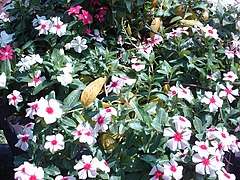
Cultivation
As an ornamental plant, it is appreciated for its hardiness in dry and nutritionally deficient conditions, popular in subtropical gardens where temperatures never fall below 5–7 °C (41–45 °F), and as a warm-season bedding plant in temperate gardens. It is noted for its long flowering period, throughout the year in tropical conditions, and from spring to late autumn, in warm temperate climates. Full sun and well-drained soil are preferred. Numerous cultivars have been selected, for variation in flower colour (white, mauve, peach, scarlet and reddish-orange), and also for tolerance of cooler growing conditions in temperate regions. Notable cultivars include 'Albus' (white flowers), 'Grape Cooler' (rose-pink; cool-tolerant), the Ocellatus Group (various colours), and 'Peppermint Cooler' (white with a red centre; cool-tolerant).[10]
In the UK it has gained the Royal Horticultural Society’s Award of Garden Merit[18] (confirmed 2017).[19]
Uses
The species has long been cultivated for herbal medicine. In Ayurveda (Indian traditional medicine) the extracts of its roots and shoots, though poisonous, are used against several diseases. In traditional Chinese medicine, extracts from it have been used against numerous diseases, including diabetes, malaria, and Hodgkin's lymphoma.[11] Many of the vinca alkaloids were first isolated from Catharanthus roseus,[20] including vinblastine and vincristine used in the treatment of leukemia[15] and Hodgkin's lymphoma.[11]
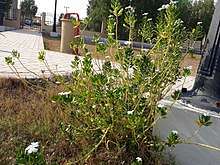
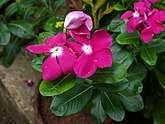
This conflict between historical indigenous use, and recent patents on C.roseus-derived drugs by western pharmaceutical companies, without compensation, has led to accusations of biopiracy.[21]
C. roseus can be extremely toxic if consumed orally by humans, and is cited (under its synonym Vinca rosea) in the Louisiana State Act 159.
C. roseus is used in plant pathology as an experimental host for phytoplasmas.[22] This is because it is easy to infect with a large majority of phytoplasmas, and also often has very distinctive symptoms such as phyllody and significantly reduced leaf size.[23]
Chemical constituents
Vinblastine and vincristine , chemotherapy medications used to treat several types of cancers, are found in the plant[24][25][26][27] and are biosynthesised from the coupling of the alkaloids catharanthine and vindoline.[28] The newer semi-synthetic chemotherapeutic agent vinorelbine, used in the treatment of non-small-cell lung cancer,[26][29] can be prepared either from vindoline and catharanthine[26][30] or from the vinca alkaloid leurosine,[31] in both cases via anhydrovinblastine.[30]
Rosinidin is the pink anthocyanidin pigment found in the flowers of C. roseus.[32] Lochnericine is a major alkaloid in roots.[33]
Gallery
 Catharanthus roseus in Kerala
Catharanthus roseus in Kerala- Vinca From a garden at Cox's Bazar Bangladesh
- Flower bud in West Bengal, India.

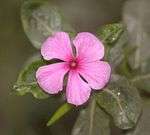
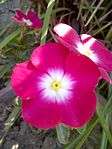 Catharanthus roseus in Pakistan
Catharanthus roseus in Pakistan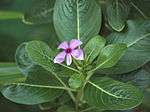 Grown in Malaysia
Grown in Malaysia Flower plant raised in India Temples
Flower plant raised in India Temples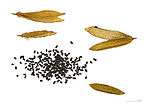 Fruits and seeds
Fruits and seeds- White rosy periwinkle
- Pacifica Burgundy Halo – Madagascar Periwinkle
- Red cultivar of Madagascar Periwinkle
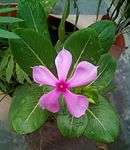 Potted Plant in New Delhi
Potted Plant in New Delhi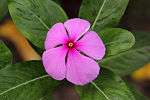 Catharanthus roseus
Catharanthus roseus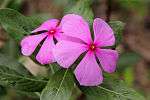 Catharanthus roseus
Catharanthus roseus_1200.jpg) Catharanthus roseus
Catharanthus roseus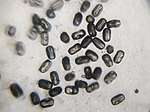 Pollen
Pollen
References
- "Catharanthus roseus, Catharanthus roseus". World Checklist of Selected Plant Families (WCSP). Royal Botanic Gardens, Kew. Retrieved 4 August 2019.
- "Catharanthus roseus, Catharanthus roseus". Germplasm Resources Information Network (GRIN). Agricultural Research Service (ARS), United States Department of Agriculture (USDA). Retrieved 4 August 2019.
- Steenis ex Bakhuizen f., Blumea 6: 384. 1950.
- G.Don, Gen. Hist. 4(1): 95. 1837.
- Markgr., Adansonia, ser. 2. 12: 222. 1972.
- Woodson, N. Amer. Fl. 29: 124. 1938.
- Bakh. f.Blumea 6 (2): 384. 1950.
- Markgr. Adansonia, ser. 2. 12: 222. 1972.
- Steenis Trop. Nat. 25: 18. 1936.
- Huxley, A., ed. (1992). New RHS Dictionary of Gardening. Macmillan ISBN 0-333-47494-5.
- Flora of China: Catharanthus roseus
- College of Micronesia: Catharanthus roseus
- Jepson Flora: Catharanthus roseus
- "Growing Periwinkle". Gardening knowhow official website. Gardening knowhow. Retrieved 4 June 2018.
- DrugDigest: Catharanthus roseus Archived 2007-09-27 at the Wayback Machine
- "Catharanthus roseus". Orpheus Island Research Station – James Cook University. Retrieved 2 November 2015.
- "Factsheet – Catharanthus roseus". Queensland Government. Retrieved 2 November 2015.
- "RHS Plantfinder - Catharanthus roseus". Retrieved 12 January 2018.
- "AGM Plants - Ornamental" (PDF). Royal Horticultural Society. July 2017. p. 16. Retrieved 24 January 2018.
- van Der Heijden, Robert; Jacobs, Denise I.; Snoeijer, Wim; Hallard, Didier; Verpoorte, Robert (2004). "The Catharanthus alkaloids: Pharmacognosy and biotechnology". Current Medicinal Chemistry. 11 (5): 607–628. doi:10.2174/0929867043455846. PMID 15032608.
- Karasov, Corliss (2001). "Who Reaps the Benefits of Biodiversity?". Environmental Health Perspectives. 109 (12): A582–A587. doi:10.2307/3454734. JSTOR 3454734. PMC 1240518. PMID 11748021.
- Marcone, C.; Ragozzino, A.; Seemuller, E. (1997). "Dodder transmission of alder yellows phytoplasma to the experimental host Catharanthus roseus (periwinkle)". Forest Pathology. 27 (6): 347–350. doi:10.1111/j.1439-0329.1997.tb01449.x.
- Chang, Chung-Jan (1998). "Pathogenicity of Aster Yellows Phytoplasma and Spiroplasma citri on Periwinkle". Phytopathology. 88 (12): 1347–1350. doi:10.1094/PHYTO.1998.88.12.1347. PMID 18944838.
- Gansäuer, Andreas; Justicia, José; Fan, Chun-An; Worgull, Dennis; Piestert, Frederik (2007). "Reductive C—C bond formation after epoxide opening via electron transfer". In Krische, Michael J. (ed.). Metal Catalyzed Reductive C—C Bond Formation: A Departure from Preformed Organometallic Reagents. Topics in Current Chemistry. 279. Springer Science & Business Media. pp. 25–52. doi:10.1007/128_2007_130. ISBN 978-3-540-72879-5.
- Cooper, Raymond; Deakin, Jeffrey John (2016). "Africa's gift to the world". Botanical Miracles: Chemistry of Plants That Changed the World. CRC Press. pp. 46–51. ISBN 978-1-4987-0430-4.
- Keglevich, Péter; Hazai, Laszlo; Kalaus, György; Szántay, Csaba (2012). "Modifications on the basic skeletons of vinblastine and vincristine". Molecules. 17 (5): 5893–5914. doi:10.3390/molecules17055893. PMC 6268133. PMID 22609781.
- Raviña, Enrique (2011). "Vinca alkaloids". The evolution of drug discovery: From traditional medicines to modern drugs. John Wiley & Sons. pp. 157–159. ISBN 978-3-527-32669-3.
- Hirata, K.; Miyamoto, K.; Miura, Y. (1994). "Catharanthus roseus L. (Periwinkle): Production of Vindoline and Catharanthine in Multiple Shoot Cultures". In Bajaj, Y. P. S. (ed.). Biotechnology in Agriculture and Forestry 26. Medicinal and Aromatic Plants. VI. Springer-Verlag. pp. 46–55. ISBN 978-3-540-56391-4.
- Faller, Bryan A.; Pandi, Trailokya N. (2011). "Safety and efficacy of vinorelbine in the treatment of non-small cell lung cancer". Clinical Medicine Insights: Oncology. 5: 131–144. doi:10.4137/CMO.S5074. PMC 3117629. PMID 21695100.
- Ngo, Quoc Anh; Roussi, Fanny; Cormier, Anthony; Thoret, Sylviane; Knossow, Marcel; Guénard, Daniel; Guéritte, Françoise (2009). "Synthesis and biological evaluation of Vinca alkaloids and phomopsin hybrids". Journal of Medicinal Chemistry. 52 (1): 134–142. doi:10.1021/jm801064y. PMID 19072542.
- Hardouin, Christophe; Doris, Eric; Rousseau, Bernard; Mioskowski, Charles (2002). "Concise synthesis of anhydrovinblastine from leurosine". Organic Letters. 4 (7): 1151–1153. doi:10.1021/ol025560c. PMID 11922805.
- Toki, Kenjiro; Saito, Norio; Irie, Yuki; Tatsuzawa, Fumi; Shigihara, Atsushi; Honda, Toshio (2008). "7-O-Methylated anthocyanidin glycosides from Catharanthus roseus". Phytochemistry. 69 (5): 1215–1219. doi:10.1016/j.phytochem.2007.11.005. PMID 18164044.
- "American Society of Plant Biologists". August 2018.
External links
